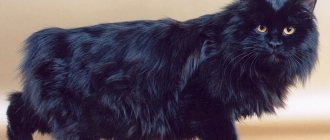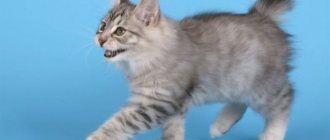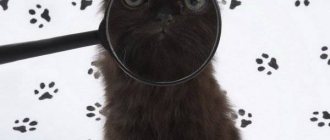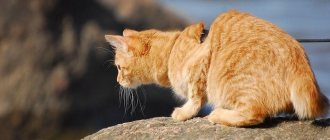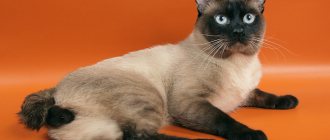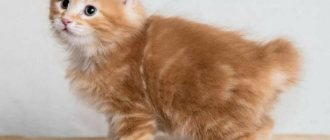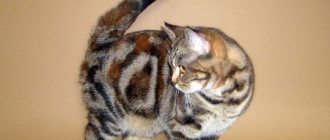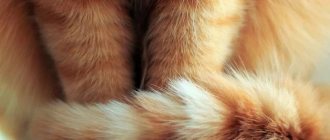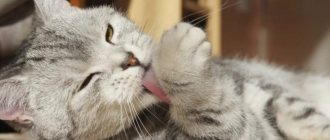How to find out a cat's breed by coat color
Very often it is possible to distinguish a purebred aristocratic cat from a simple Murka by color.
Domestic cats are usually very plainly colored, two or three colors, and have large spots or stripes. Experts have worked thoroughly on the colors of purebred animals. Sometimes you can immediately determine the specific breed of a kitten using this feature.
Siamese
The striking Siamese color, the so-called color point, is characterized by darker areas on the cat's face, ears, paws and tail.
Initially, only Thai or Siamese cats could boast of this, but over time, breeders gave this coloring to many breeds:
- Balinese;
- British;
- Neva Masquerade;
- Himalayan;
- Burmese;
- Persian;
- ragdoll, etc.
Cat with Siamese color - Balinese
Himalayan cat with Siamese color
There are several varieties of point colors in cats, depending on the contrast of colors and the smoothness of the transition from dark to light:
- seal point - soft cream;
- blue point - silver-blue;
- chocolate point - brown-chocolate;
- lilac point - pinkish-bluish;
- red point - pronounced apricot (red);
- cream point - delicate beige-amber;
- caramel point - grayish-beige;
- cinnamon point - red-brown;
- fawn point - pale cream.
Chocolate point cat
Only a specialist felinologist can competently determine all the nuances of point colors. A kitten is always born white. The marks (points) begin to darken after a few days.
Blue
Solid blue color, also known as grey, is traditionally considered an integral feature of British breed cats. It can be detected immediately even in a newborn kitten. But in fact, all shades of grayish blue are also found in many other purebred representatives of the cat world, such as:
- chartreuse;
- Maine Coon;
- Russian blue;
- Scottish;
- oriental;
- Nibelung;
- korat etc.
Breed: Russian Blue cat
Sand
If the kitten has a rare sand or red color (sorrel), then this allows us to determine whether it corresponds to one of the breeds:
- Somali;
- Abyssinian
A cat with a sorrel coat color is an Abyssinian breed
Wild
Natural animal colors, making cats smaller copies of tigers and leopards, are called wild (tabby) and are found in the following breeds:
- savannah;
- ocicat;
- Serengeti;
- Bengali;
- Egyptian Mau;
- caraquet;
- Kanaani;
- Kurilian bobtail;
- safari, etc.
Kurilian Bobtail - wild-colored cat
Most often, wild colors are characteristic of hybrid breeds. You can instantly determine who belongs to them.
Brown
The uniform and monochromatic brown color of a kitten's fur coat will immediately determine its royal origin and worthy position in the cat elite. This color is practically never found in the wild.
Cats of the following breeds come in similar colors:
- British;
- oriental (havana brown);
- Burmese;
- Scottish;
- Abyssinian;
- Persian;
- Chantilly-Tiffany, etc.
Burmese - a cat with a brown color
Origin of tailless cat breeds
Cats appeared on Earth much earlier than humans. Therefore, it is impossible to take into account the participation of primitive people in their selection. Nature has independently worked on the diversity of species, and the survival of representatives of the cat family proves their adaptability to any evolutionary surprises.
The first version is based on rationality - mother cats simply bit off the tail of their newborn offspring. Thus, they deprived the babies of an unprotected part of the body, which an enemy could grab in a fight.
There is also an opinion that numerous offspring did not fit in a cramped den and became easy prey for predators who pulled the kittens out of the shelter by their long tails.
The next hypothesis is the origin of cat breeds without a tail from lynxes. They belong to the same family - in the appearance and habits of the first and second there are so many common features that the thought of a close relationship involuntarily arises.
The third version began to be considered with the development of genetics. An uncontrolled natural mutation is suspected due to the original limited geographic range in which tailless cats lived. Early reports of them include:
- to island territories;
- to distant countries that led a closed lifestyle.
Under such conditions, inbreeding, arbitrary gene mutations and the consolidation of the characteristic characteristics of the breed occurred. Their genes dominated in subsequent selection relationships with indigenous breeds of other territories.
According to their characteristic features, all cats without a tail are divided by international felinological associations into 3 groups:
- Rumpy - the animal has no tail.
- Riser – very small, visible only in short-haired cats. Hidden in long-haired or semi-long-haired breeds.
- Stumpy - arbitrary length, but shorter than regular cats.
The inherited instructions of the tailless mutation are not universal and are not determined by any one property in all cats. Researchers suggest a complex involvement of dominant genes and polygenes that influence the overall characteristics of animals.
Let's get acquainted - Menx
What do we know about the Menskaya cat breed? These cute pets came to us from Ireland. As you may have guessed, their homeland is the Isle of Man. What caused the appearance of an animal without a tail is not known for certain; there are many conflicting legends and rumors, but they can serve as proof of the rich imagination of local residents and nothing more. Most likely, the absence of a tail is a gene mutation as a result of numerous incests on a limited island territory.
Menx is a very cute creature. Representatives of this cat breed do not need outdoor adventures. They love their home and all its inhabitants. Their friends can be dogs, hamsters, parrots - any animals living in the same apartment with them.
Men's cats love water. They enjoy jumping into the bath or watching the tap open.
Menx grow quickly, but mature slowly; this feature of the breed makes them cheerful and playful much longer than others.
What else do we know about tailless Menx?
Representatives of the tailless breed of Menx cats have their own classification:
- Rampi is a completely tailless cat;
- rumpy riser (rised), riser - a cat whose tail looks like a small stump, since it retains part of the cartilage at the base of the tail;
- Stumpy is a type of cat whose tail is much shorter than the standard length, it consists of two to three vertebrae;
- longi or taili - a cat with a tail of normal length.
All these varieties can appear within the same litter.
The main differences between purebred pets and domestic ones
A purebred cat always has one or more distinctive characteristics that allow it to be classified as a particular breed. This could be an interesting color, unusual ear structure, iris color, etc.
These qualities are fixed by the standard, so representatives of the same breed are quite similar to each other. But the differences between cats of different breeds can be dramatic.
Non-pedigree cats differ much less from each other in appearance. They can be identified by the following unifying characteristics:
- medium-sized, high-set triangular ears sticking straight up;
- regular shaped round head;
- elongated, graceful body of correct proportions;
- muscular, long paws with soft pads and sharp claws;
- well-set round eyes;
- an energetic and agile long tail that well expresses all the cat’s emotions.
Dragon Li
At first glance, this breed is no different from ordinary domestic cats, but the distinctive feature of the Li Mao breed is green or yellow slightly slanted almond-shaped eyes, and small black dots (in the form of a smile) at the edges of the mouth. And also a strong, muscular body, proportional paws of equal length, an elongated head with a rounded forehead, rounded ears and, of course, a long tail. Brown tabby is the only color recognized for this breed.
Dragons are smart cats with a calm character. Because of this, they are easy to train and learn. They get along easily with other pets, but have a hard time getting used to children (although they treat them with due tolerance). Li dragons do not require special care and do not have hereditary diseases.
Cymric
Registered in the Isle of Man. Recognized as a separate breed in 1976.
Medium sized animals. Longhaired with thick undercoat. Strong muscular body. The tail is 1 vertebra in size.
Cymrics are balanced and loving. They cannot stand loneliness. Active and curious. Get along well with other animals. They require daily grooming.
Dream Interpretation - Cat as a symbol
According to Indian myths, a cat is an animal that belongs to the great goddess, the guardian of all newborns. This goddess is usually depicted riding a cat, which is why in India she is revered as a sacred animal. According to the beliefs of the ancient Germans, a person who loves cats will be happy in marriage, while one who has an aversion to cats will marry a grumpy and angry woman. In any case, he will not have children. In all fairy tales, myths and legends, cats accompany witches, goddesses and fairies. The cat represents femininity, softness and charm. However, later (in the Middle Ages) this animal began to be considered a companion of witches, so cats were persecuted. In dreams, a cat symbolizes feminine attractiveness, magnetism and sensuality. In Indian mythology and fairy tales of different peoples of the world, the forest is the habitat of the creator god. However, there is another interpretation. In Vaishnavism and Krishnaism, the world is a “forest of eternal joys,” a place of mystical experience. Symbols have a similar interpretation in dreams. Look in any dream book - the forest has many meanings, but we are interested in a different interpretation. There are many dangers in the forest, but those who go through it to the end can experience sensual joys, love and desire.
Read with this
Diseases
The immunity of cats of this breed is enviable. But they also have weaknesses.
The first thing you should pay attention to is the ponytail, or more precisely, the area under it. At the very first inspection, find out whether there are any cracks, irritation or ulcers.
Such a short length is a prerequisite for the occurrence of an inflammatory process or prolapse of the anus. The Kurilian Bobtail should be examined regularly, and if damage is found, take it to a veterinarian for examination. Remember: if you feed your cat poorly, he will develop this kind of illness quickly.
Ordinary sea buckthorn oil helps to deal with small cracks: they lubricate the anus area with it and make sure that the cat does not lick it right away.
The second nuance: in Kuril Bobtails, the urine pH is significantly different from the urine of cats of other breeds (7-7.5 versus the usual 6-6.5). Therefore, they rarely suffer from urolithiasis of the alkaline type.
Timely and regular vaccination will help protect your pet from a number of diseases - rabies, rhinotracheitis, panleukopenia, calicivirus, leukemia, peritonitis. The kitten receives its first vaccinations at the nursery, but in the future you will have to learn the vaccination calendar and take your pet to the doctor yourself.
Information about the procedures is entered into the veterinary passport. You should not vaccinate yourself (if you do not have the appropriate education: a mistake can lead to serious consequences. Do not try to vaccinate your pet against all diseases at once: this is too much stress on the immune system!
How to care for the Kurilian Bobtail
The breed is distinguished by cleanliness and a constant desire to “beautify” and groom itself. Breeders associate this behavior with echoes of the wild past. After all, in the natural habitat it is important to remain unnoticed in order to preserve life. And smells can “give away” the presence.
Kurilian bobtails are noble cleanliness
Fluffies are bathed at least once every two months, and if the fur is very thick and long, then more often (every month). You should not indulge your pet’s desire to splash around in the water, because frequent baths dry out the skin and deteriorate the quality of the coat.
If you buy a short-haired chicken as a pet, then there will be no problems with the fur coat. During molting, the fur of these cats sheds in moderate amounts.
The situation is different with long-haired purrs. To keep the coat well-groomed, you need to comb the animal 1-2 times a week using a special brush with long, sparse teeth. A positive feature of the Kuril Bobtail is the inability of their fur to mat into shreds and tangles. But this fact should not cancel regular care for your pet’s fur coat.
It is also advisable to groom your furry animal once every six months (a set of cosmetic and hygiene procedures). Especially in the hot season. This will make life easier for both the pet and family members.
As necessary, you need to clean the corners of the purring eyes with a cotton swab dipped in warm water, and carefully remove accumulated dirt from the ears with a cotton swab.
When choosing a toilet for your Kurilian Bobtail, you need to pay attention to the shape of the tray and the size of the filler. For short-haired pets, both semi-closed and open toilets are suitable. The filler is also selected at the discretion of the owner. But for long-haired Kurils, it is better to purchase open trays and filler with large particles. It is advisable to choose the composition of the filler from high quality wood.
It will not be difficult to train a cat to use the toilet, because these bobtailed purrs are very smart. It is enough to put your pet in the tray two times in a row after eating, and the animal will understand and accept the new rules.
Feeding the Kuril Islands
Since Kurilians are natural hunters, the diet of domestic shorttails should contain a large amount of meat. However, you cannot switch your pet to a completely meat diet. After all, such a diet can lead to protein poisoning.
Natural food is important for Kurilian Bobtails
Other dietary features of Kurilian Bobtails are:
- availability of clean drinking water;
- adding complexes with calcium and phosphorus to the diet when feeding only natural food;
- inclusion of hard pieces in dishes - cartilage, bones, chicken gizzards;
- if the food is ready-made (dry or canned), then preference should be given to high-quality premium or super-premium types;
- to maintain the balance of nutrients in the body, the cat should be given cleaned fish two to three times a week;
- All food must be thoroughly boiled.
Smoked meats, sweets, flour products and milk are prohibited for bob-tailed cats. Bread and pastries, as well as raisins, avocados and nuts, should also not be given, since these foods cause digestive disorders and stool problems in cats.
The feeding regimen includes two meals a day of 160–180 g per serving for adults. Kittens are given food four times a day, and the portion is calculated based on body weight. The volume of food eaten at a time should not exceed 5% of the animal’s weight. This rule is also true for mature purrs.
The most famous representative is the Bobtail
“Bobtail” translated from English means “short tail.” The general name of the breed combines several different types of cats from around the world. Each subspecies has its own habits, character and body structure.
American Bobtail
The father of this breed was the cat Yodi, who lived on a South American Indian reservation. In 1970, a standard for this breed was adopted, and the American Bobtail gained worldwide recognition only in the early 90s. These cats are very similar to lynxes, and they can come in a wide variety of colors. There are elegant tassels at the tips of the ears, a dense build, a slightly elongated body and massive paws.
They have a playful character and can be affectionate. Smart and easy to train animals. Freedom-loving. They need extra care for their long and thick coat. Problems may arise during reproduction.
Japanese Bobtail
This cat breed has been known in Japan for hundreds of years. How and under what circumstances the breed was formed is unknown. In their homeland, these cats bear the proud name Mi-ke.
How to properly care for a Sphynx
Medium size breed. The tail is 5-7 cm long and has a special structure in each individual. Unusual triangular head with narrow eyes and a long nose. Medium length coat without undercoat. Tricolor color: black, red and white.
They are characterized as intelligent and friendly cats. They love to swim. Suitable for keeping in an apartment. Easy to learn.
Kurilian Bobtail
A relatively young breed of cats, bred in Russia. It was first presented at the exhibition in the 80s of the 20th century.
The tail length is no more than 15 cm. The tail structure of each individual is unique. The animals are large, strongly built with powerful paws (the front ones are shorter than the back ones).
The character of these cats is often compared to that of a dog. Freedom-loving, but very loyal animals. They don't mark the territory, they don't smell like cats. They love to fish and hunt. Not fully domesticated.
Karelian Bobtail
The breed was formed as a result of natural mutations. The habitat of aboriginal cats is the coast of Lake Ladoga. In selection from phylinologists since 1992.
Tail length is 4-12 cm. There are a wide variety of colors. The cat is medium-sized, strong-built with well-developed muscles. The front legs are much shorter than the hind legs. The coat can be either long or short.
Karelian Bobtails become very attached to their owner. Very affectionate and friendly. Unpretentious in care. They rarely get sick.
Mekong Bobtail (Royal Bobtail)
It was born as a “by-product” of the breeding of Siamese cats. The Russian breeder, having received several short-tailed kittens, continued his work. As a result, a new breed of bobtail.
10 Dumbest Cat Breeds
A distinctive feature is the Siamese color. The structure of the tail is unique for each individual. Short dense body. The hind legs are longer than the front legs. Wedge-shaped head. Short coat with undercoat. Eye color is blue.
They are described by breeders as intelligent and sociable cats. They often live up to 20 years. The coat requires additional care.
Toy bob
The progenitor of Toy beans is considered to be a Russian cat named Kutsy, born with a mutation in Rostov-on-Don in 1988. The breed was registered as experimental by American breeders in 2009. The second name is Skif-toy-don.
A miniature cat with a strong build and well-developed muscles. Tail length 3-7 cm. Dense coat. There are both short-haired and semi-long-haired animals.
These cats have dog-like habits. Easy to learn commands. Trusting and fearless. Males of this species do not mark territory and have no characteristic odor.
Pixie bob
"Pixie Bob" translates from English as "Elf with a short tail." The breed was obtained through long and painstaking selection by American breeders. Registered in 1995.
Very similar to a lynx. A special feature is polydactyl paws. The body of the animal is medium in size. Males are 2 times larger than cats (females 3-5 kg, males 5-10 kg).
These cats have few kittens in their litter (maximum 3). They are characterized by breeders as unobtrusive in communication with the owner and wary with strangers. It is extremely rare to release their claws. Not aggressive. Unpretentious in care.
7 Cat Breeds with Amazing Chocolate Colors
Where does the Kurilian Bobtail come from?
Cats with short, curled tails appeared on the islands of the Kuril archipelago 200 years ago. Then these smart and dexterous animals were noticed by local fishermen. And they began to feed them so that the furry predators would protect their houses from rats and poisonous snakes.
Photo gallery: Kurilian Bobtail in its natural habitat
Kurilian Bobtails are skilled hunters
Kuril residents are also excellent swimmers
These cute fluffies are not even afraid of snakes
The Russians who arrived in the Kuril Islands also did not remain indifferent to these seals and even began to take the animals as pets to the mainland. So, thanks to geologists and the military, Kuril bobtails reached Eurasia.
In 1980, felinologists became interested in the breed and noticed its unusual curved tail. It was believed that such a specific part of the body became under the influence of radiation or other harmful influence from the outside. However, further research proved the completely natural origin of the genetic feature of the Kuril Islands.
In addition, Kurilian bobtails were mistaken for a variety of Japanese bobtail cats. But in the end, the professionals agreed that the Japanese bobtails were only the ancestors of the Kuril ones. And that's only half. After all, the Kurilians are found to have more similarities with the Siberian purrs. And the latter are classified as a breed that was crossed in the natural environment with the Japanese bobtail.
Photo gallery: representatives of related breeds: Kurilian bobtail, Siberian cat and Japanese short-tailed cat
Kurilian Bobtails are a hybrid of two cat breeds
Siberian cats are the closest relatives and ancestors of the Kurilian Bobtail
From the Japanese bobtails, the Kurils inherited only a short tail
In October 1991, the Soviet Felinological Federation (SFF) approved the breed standard for Kuril Bobtails.
In 1994, cats were recognized by TICA felinologists, and 1995 became a significant year for these purrs. Kurils are officially recognized in the felinological world. First the SFF did this, and then the World Cat Federation.
In 2002, the Kurilian Bobtail was recognized by such a respected organization as FIFe, which gave a new round in the development of the breed. But the TICA champion status was recognized only in 2012. In addition, bobtailed smokers have not yet been recognized by the authoritative CFA community.
Currently, these furry pets are becoming more and more popular, and not a single international exhibition is complete without representatives of Russian short-tailed cats.
Health
This breed boasts strong and good health. They have virtually no predisposition to genetic diseases. The occurrence of such diseases is possible only if the crossing of parents was carried out incorrectly. For example, one of them is a representative of a hybrid breed.
In other cases, health problems may arise due to improper care and feeding of the animal. If the amount of carbohydrate food in the diet exceeds the norm, there is a risk that the cat will suffer from obesity and diabetes. Neglecting to brush your teeth can lead to periodontitis.
Hybrid breeds
During breeding work, several more breeds of cats with short tails were developed.
Pixiebob
The result of crossing a wild lynx and a short-haired cat. Animals are highly talkative, so you need to be prepared for constant rumbling, purring and chattering under the ear. Cats love to be the center of attention and follow their owner wherever he goes and whatever he does. They feel great outside the home, going with the family on picnics or long journeys. They can walk on a leash and follow some commands. Pixiebobs have high intelligence, which gives them a head start in many games - both active and static. They get along well with children, but you need to make sure that they treat the cat with due respect and do not offend it.
On average, animals live 13-15 years and have no predisposition to hereditary diseases.
- The most affectionate breeds of cats and kittens
- Ratcatcher cats: the best breeds
- New cat breeds
Short tail
It is noteworthy that the presence of a tail in a “rudimentary” state or its complete absence in cats is a sign of “noble” origin (in contrast to the same domestic dogs, whose tails are docked deliberately - to fit the animals to the standards of a particular breed). It is worth noting that there are only a few types of short-tailed/“tailless” cat breeds, which include:
Kurilian Bobtail
a short curved tail approximately 5-9 cm long, resembling a fluffy pom-pom and characterized by mobility, a relatively small body with strong bones, developed muscles and limbs of medium length, a triangle-shaped head with medium-sized eyes corresponding to the color, short-haired or semi-long-haired, but in in any case, with a fluffy collar on the neck and chest.
more details
American Bobtail
a short and flexible tail from 2.5 to 8 cm long (it can be straight, curved, and slightly curled at the end), a body of medium length with an athletic build and strong paws proportional to it, a round muzzle with strong jaws and ears, an internal the surface of which is covered with long fluffy hairs, short or long hair, but always thick and slightly harsh.
more details
Japanese Bobtail
a short tail no more than 12 cm long (straight, curled, curved or in the form of a pompom), a long and lean body with a flat back and slender legs (the hind legs are noticeably longer than the front ones), a muzzle with large oval-shaped eyes and large, wide-set ears, soft and silky coat of medium length.
more details
Mekong Bobtail
a short and broken tail with a length of at least three vertebrae (but no more than a quarter of the length of the body itself), a strong and muscular body of medium size with long legs, a wedge-shaped head with medium-sized ears (with rounded tips) and slightly slanted eyes, always bright blue , short silky coat with minimal undercoat.
Karelian Bobtail
a short tail 4-13 cm long (can be either kinked or almost straight), a strong body with an even posture and proportional paws, a narrow head with a small strong chin and rather large ears with tiny “tassels”, short or long hair ( necessarily dense).
Kurilian Bobtail
“no, not a relative”
short tail 3-8 cm long (with pronounced kinks), strong build with a slightly arched back and powerful paws, large trapezoidal head with a powerful chin and proportional ears, short or long hair (very soft to the touch).
more details
Pixiebob
short straight (but possible kinks) tail about 5 cm long, large and muscular body build with powerful bones and a clearly defined arch on the back, large pear-shaped head, tightly knit and strong paws (the hind legs are noticeably longer than the front ones), short or moderately long hair with different color options, but always with small or medium spots throughout the body.
more details
Manx cat
they may either have no tail completely, or have a small “stump” hidden under the fur, or generally have a tail of normal length, a medium-sized round body with a round head, powerful limbs with well-developed muscles (the front ones are noticeably shorter than the back ones), round eyes with a slight slant, short and thick coat, like “plush”.
more details
Cymric cat
Kymrik
tailless breed (but there can be either a “stump” or even a full tail), a tightly built physique with a wide chest and an arched back, short front and long hind limbs (with heavy shins), thick hair of medium length.
more details
Cat breed with short tail
As you know, there is no arguing about tastes - some people like cats with a fluffy long tail, while others admire a short-tailed kitten. There are several cat breeds that have a short tail, and there are also cats without a tail at all.
The common name for short-tailed cat breeds is bobtail, from the English “bobtail,” which means “cut tail.” Bobtail can be short-haired (Japanese, Thai) and with hair of different lengths (American, Kuril, Karelian).
The oldest of these breeds is the Japanese Bobtail. This small graceful cat comes from the Land of the Rising Sun. Representatives of this cat breed are bicolor or tricolor, most often with red and black spots on a white background.
Japanese and Thai bobtails differ in color. The Thai (Mekong) Bobtail has a characteristic Siamese color and blue eyes. This graceful cat has a short tail with kinks and hooks, which is considered a characteristic of the breed.
The American Bobtail is a stocky, rather large cat with a pom-pom tail. A pet of this breed can be short-haired or long-haired, any color is allowed.
The Kurilian Bobtail is a cat breed that was formed without the participation of breeders. This is a large animal, its weight can reach 7-9 kg. The coat is allowed to be short or long, the color is arbitrary.
The Karelian Bobtail can also be long-haired or short-haired, any coat color is recognized. These varieties differ from each other in size (the Karelian bobtail is more graceful and smaller than the Kurilian).
In addition to the bobtail, there is a rarer breed of cat with a short tail - the pixie bob.
This is an unusual short-tailed cat that resembles a lynx. Pixie bob is quite large, its weight reaches 10 kg. These cats have a “bunny” tail and tufted ears, and their paws can have 5-7 toes. Pixie bobs are short-haired or semi-long-haired, and the color is tabby (striped).
In addition to cats with short tails, there are completely tailless cat breeds, Manx and Cymric.
Manx (Manx tailless cat) got its name from the Isle of Man in the Irish Sea. A distinctive feature of this cat, in addition to the absence of a tail, is its “jumping” gait (like that of a rabbit), since its front legs are shorter than its hind legs. She has thick, short, plush fur, and any color is allowed.
Cymrik is an adorable long-haired, tailless cat that resembles a bear cub. This is a cross between a Manx and a Norwegian forest cat.
Short-tailed cats not only have a memorable appearance, but also an outstanding character. Many of them resemble dogs - they are able to follow commands, are very devoted to their owners and follow on their heels.
Manx cat
The first individuals arrived on the Isle of Man with Finnish or Spanish sailors.
The tail is completely absent. Short coat with undercoat. Large build, front legs shorter than hind legs.
Affectionate, inquisitive and incredibly campaigning cats. They quickly find a common language with children and dogs. Navyazchevs. Prone to various diseases.
